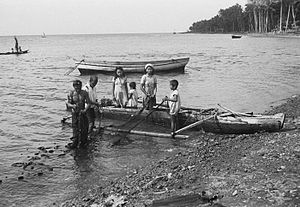Sangir, Sangihe, Sangil | |
|---|---|
 A fishing family outside at the beach with net in Sangir Island, December 1948. | |
| Total population | |
| approx. 600,000 people | |
| Regions with significant populations | |
North Sulawesi: 449,805 Gorontalo: 7,489 North Maluku Mindanao: 16,014 (2010)[2] | |
| Languages | |
| Religion | |
| Christianity (mainly Protestant) 79%, minority Sunni Islam 20% | |
| Related ethnic groups | |
Sangir (Sangihe, Sangil) is a native people of the Sangir Islands in the northern chain of islands in Sulawesi and the southern part of Mindanao. The Sangirese people are fishermen and nutmeg growers in their home areas and also work as wage labourers in industrial crops enterprises in Bolaang Mongondow Regency and Minahasa Regency.[3]
The Sangirese have traditionally been concentrated in the province of North Sulawesi in Indonesia and the Region of Dávao in the Philippines.[4] Many Sangirese migrants inhabit mainland Sulawesi,[5] as well as North Maluku, including Ternate and Halmahera.[6][7] The (Muslim) Sangil of the Philippines, who represent an early migrant group, are ethnically distinct from the (predominantly Christian) Sangirese of Indonesia,[8][9] and are considered part of the Moro.[10]
Genetic studies have shown that the Sangil have partial Papuan descent.[11]
- ^ Indonesia's Population: Ethnicity and Religion in a Changing Political Landscape. Institute of Southeast Asian Studies. 2003.
- ^ "2010 Census of Population and Housing: Philippines" (PDF). Philippine Statistics Authority.
- ^ University of British Columbia (1979). Sulawesi Regional Development Study: Final Report, Volumes 1-5. Department of Public Works, Directorate General of Housing, Building, Planning and Urban Development, Directorate of City and Regional Planning.
- ^ Mick Basa (9 March 2014). "The Indonesian Sangirs in Mindanao". Rappler. Retrieved 2017-12-25.
- ^ Mead, David, "Sangir", Sulawesi Language Alliance, archived from the original on 2023-01-17, retrieved 2023-01-17
- ^ Grimes, Charles E.; Grimes, Barbara D. (1994). "Languages of the North Moluccas: a preliminary lexicostatistic classification". In Masinambow, E.K.M. (ed.). Maluku dan Irian Jaya. Buletin LEKNAS. Vol. 3(1). Jakarta: LEKNAS-LIPI. pp. 35–63. OCLC 54222413.
- ^ Duncan, Christopher R. (2013). Violence and Vengeance: Religious Conflict and Its Aftermath in Eastern Indonesia. Ithaca: Cornell University Press. p. 59. doi:10.7591/cornell/9780801451584.001.0001. ISBN 978-0-8014-6910-7. JSTOR 10.7591/j.ctt32b65z. OCLC 865508920.
- ^ Gowing, Peter G. (1984). "Sangil". In Weekes, Richard Y. (ed.). Muslim Peoples: A World Ethnographic Survey. Vol. 2 (2 ed.). Westport, CT: Greenwood Press. pp. 659–660. ISBN 0-3132-4640-8. OCLC 9970261.
- ^ Levinson, David, ed. (1993). "Sangir". Encyclopedia of World Cultures. Vol. 5. Boston, MA: G.K. Hall. p. 224. ISBN 081688840X. OCLC 22492614. Archived from the original on 2022-12-27. Retrieved 2022-12-27 – via encyclopedia.com.
- ^ Non, Domingo M. (2011). "The Odyssey of Sangil in Mindanao". The Journal of History. 57 (1): 81–93. ISSN 0117-2840. Retrieved 2024-07-11.
- ^ Larena, Maximilian; Sanchez-Quinto, Federico; Sjödin, Per; McKenna, James; Ebeo, Carlo; Reyes, Rebecca; Casel, Ophelia; Huang, Jin-Yuan; Hagada, Kim Pullupul; Guilay, Dennis; Reyes, Jennelyn (2021-03-30). "Multiple migrations to the Philippines during the last 50,000 years". Proceedings of the National Academy of Sciences. 118 (13): e2026132118. doi:10.1073/pnas.2026132118. ISSN 0027-8424. PMC 8020671. PMID 33753512.